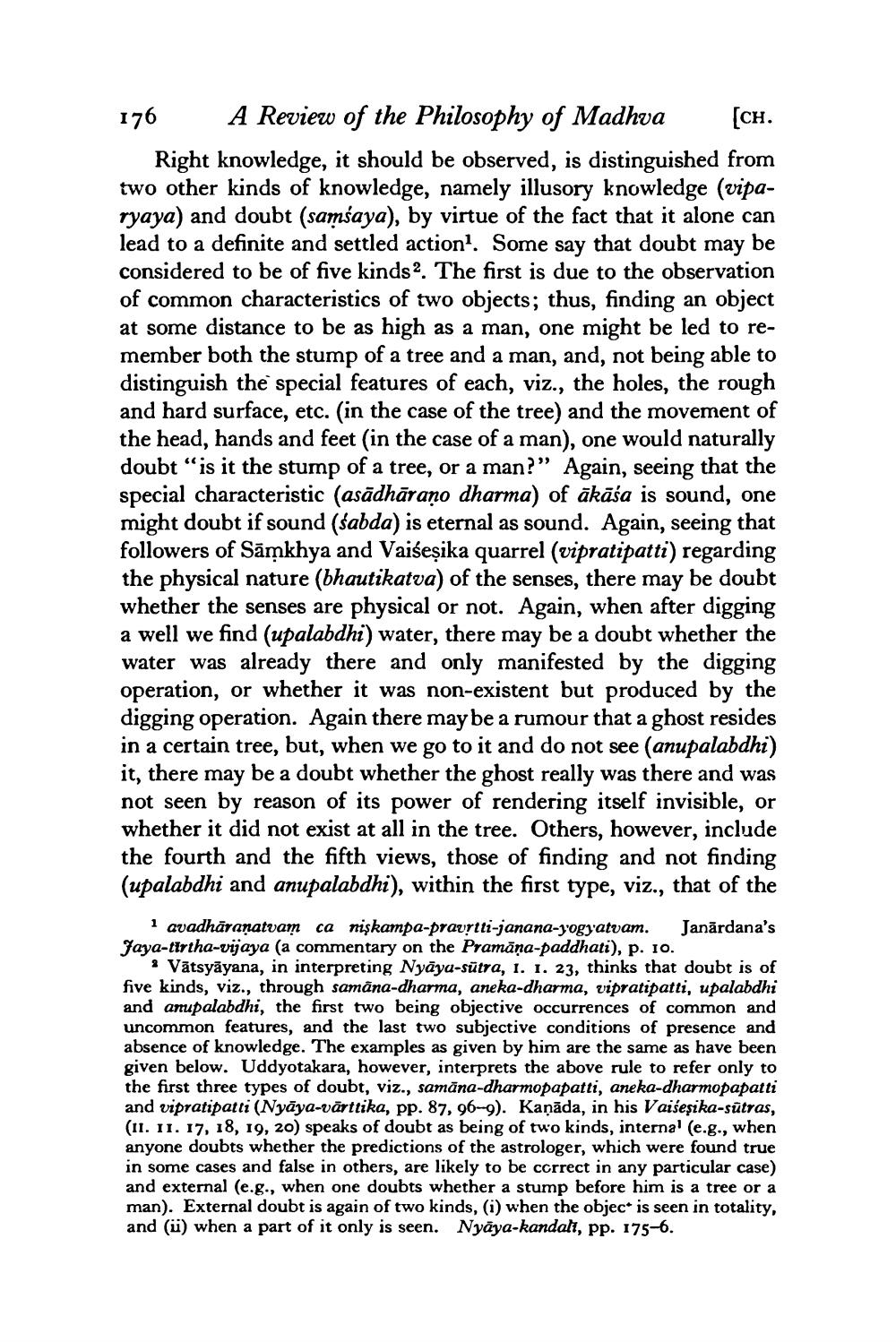________________
176 A Review of the Philosophy of Madhva [CH.
Right knowledge, it should be observed, is distinguished from two other kinds of knowledge, namely illusory knowledge (viparyaya) and doubt (samsaya), by virtue of the fact that it alone can lead to a definite and settled action'. Some say that doubt may be considered to be of five kinds 2. The first is due to the observation of common characteristics of two objects; thus, finding an object at some distance to be as high as a man, one might be led to remember both the stump of a tree and a man, and, not being able to distinguish the special features of each, viz., the holes, the rough and hard surface, etc. (in the case of the tree) and the movement of the head, hands and feet (in the case of a man), one would naturally doubt “is it the stump of a tree, or a man?” Again, seeing that the special characteristic (asādhāraño dharma) of ākāśa is sound, one might doubt if sound (sabda) is eternal as sound. Again, seeing that followers of Sāmkhya and Vaiseșika quarrel (vipratipatti) regarding the physical nature (bhautikatva) of the senses, there may be doubt whether the senses are physical or not. Again, when after digging a well we find (upalabdhi) water, there may be a doubt whether the water was already there and only manifested by the digging operation, or whether it was non-existent but produced by the digging operation. Again there may be a rumour that a ghost resides in a certain tree, but, when we go to it and do not see (anupalabdhi) it, there may be a doubt whether the ghost really was there and was not seen by reason of its power of rendering itself invisible, or whether it did not exist at all in the tree. Others, however, include the fourth and the fifth views, those of finding and not finding (upalabdhi and anupalabdhi), within the first type, viz., that of the
1 avadhāranatvam ca nişkampa-praurtti-janana-yogyatvam. Janārdana's Jaya-tirtha-vijaya (a commentary on the Pramāna-paddhati), p. 1o.
? Vātsyāyana, in interpreting Nyāya-sutra, 1. 1. 23, thinks that doubt is of five kinds, viz., through samāna-dharma, aneka-dharma, vipratipatti, upalabdhi and anupalabdhi, the first two being objective occurrences of common and uncommon features, and the last two subjective conditions of presence and absence of knowledge. The examples as given by him are the same as have been given below. Uddyotakara, however, interprets the above rule to refer only to the first three types of doubt, viz., samāna-dharmopapatti, aneka-dharmopapatti and vipratipatti (Nyāya-vārttika, pp. 87, 96-9). Kaņāda, in his Vaišeşika-sūtras, (11. II. 17, 18, 19, 20) speaks of doubt as being of two kinds, internal (e.g., when anyone doubts whether the predictions of the astrologer, which were found true in some cases and false in others, are likely to be correct in any particular case) and external (e.g., when one doubts whether a stump before him is a tree or a man). External doubt is again of two kinds, (i) when the objec is seen in totality, and (ü) when a part of it only is seen. Nyäya-kandalt, pp. 175-6.




